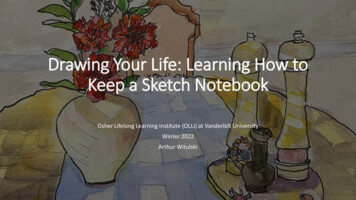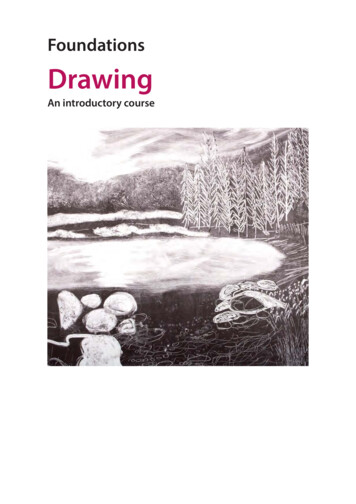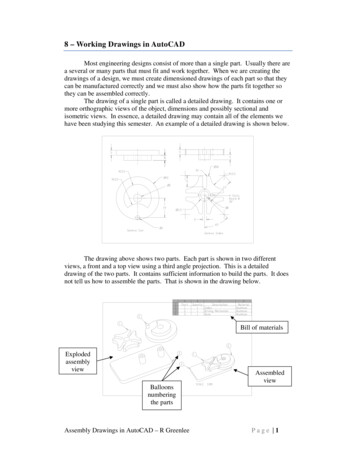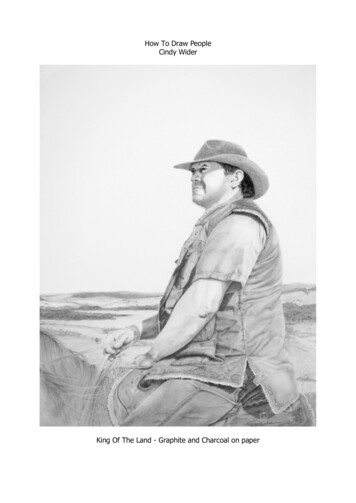
Transcription
Drawing Your Life: Learning How toKeep a Sketch NotebookOsher Lifelong Learning Institute (OLLI) at Vanderbilt UniversityWinter 2022Arthur Witulski
A little bit about me Electrical engineering professorLast took a class in art in Junior High SchoolMy Mom was a watercolor painter in her spare time2004-Class on “Drawing on the Right Side of the BrainKept taking classes for about 10 years, acrylics, oils,watercolor Last few years: plein air painting, urban sketching Taught a spring 2021 freshman seminar on UrbanSketching
What is a Sketchbook Journal? Simply a visual record of the objects, people, scenes of your life It’s a sketch, not a finished drawing or painting Done in a limited time, at least started on location Kept in a notebook-gives you as sense of progress or time elapsing Mostly recorded from life-drawing from things around you ratherthan photos-drawing from 3D rather than 2D Can be mostly drawing, or mostly text, or a mixture of the two
Sketch, Not Finished Artwork10 Minutes15 Minutes
Sketch, Not Finished Artwork40 Minutes15 Minutes
Sketch, Not Finished Artwork1 Hour
Sketch, Not Finished Artwork1.5 HourEntirely on locationBicentennial CapitolMall State Park inNashvilleInk and watercolor
Finished Artwork 4 HoursWatercolor painting from photoMultiple layers and adjustmentsJust three colors
Combination of Text and FiguresCan merge textand figures
Sketches fromVarious Artists Tommy Kane These artists been sketching along time-but give us inspiration Looks like just two ballpointpens, blue and black https://www.tommykane.com
Sketches fromVarious Artists Greg Betza Ink and wash-fast technique See more sketches atwww.urbansketchers.org Betza
Sketches fromVarious Artists Neil Whitehead This sketch from Pinterest, UrbanSketchers Ink and watercolor Alternates warm and cool colors neilwhitehead.co.uk
For a sketch,we have toadjustexpectations Limited amount of time Outdoors, the light is changing quickly Circumstances change, e.g., a car parksbetween you and your scene Have to choose one element, focus on theone thing we want to communicate orremember Don’t have time for corrections
For a sketch,we have toadjustexpectationsHot Springs AR, drawing, interrupted
Why Keep aSketchbookJournal? Helps you slow down, activate the right side ofyour brain, experience the present Learn art concepts like perspective and colortheory, learn to see Get away from screens-look at things fromdifferent distances Excuse to be outside-experience nature a littlemore Appreciate the complexity around us in objectsand scenery Meet people you wouldn’t otherwise meet Photos are good for line and shape, not for colorand value Enhances your experience of a place Deeper memories
But can I reallylearn to draw ?“Drawing on the Right Side of the Brain Class, 2004First effort at drawing a hand
But can I reallylearn to draw?”Blind” drawing of my own hand, minutes later
But can I reallylearn to draw?”Peek” drawing of my own hand, minutes later
But can I reallylearn to draw?”Blind” drawing of my shoe, same class 2004
But can I reallylearn to draw?”Peek” drawing of my shoe, same class 2004
Yes! You CanLearn to Draw Avoid accessing the stored symbolic forms inthe left side of your brain Access the spatial capability of the right sideof your brain Learn to draw what you actually see, not whatyou think you see: “Perceptual Skills” Learn the principles of drawing, such asperspective, relative size of shapes, light anddark values, line width, and composition Drawing is a skill that can be learned! Betty Edwards https://www.drawright.com/ Book: “Drawing on the Right Side of the Brain” http://www.howtodrawjourney.com/
Sketchbook Supplies-See Handout
Overview ofRemainingLectures1. What is keeping a sketchbook-today’s lecture2. Sketching Objects-the things in your life 3D 2D1. Basic forms: sphere, box, cylinder2. Basic shading and shadows3. Sketching interior scenes-the rooms of your life1. Basic perspective2. Measuring-determining the size of things4. Sketching outside-the scenes of your life1. Fore-middle-background2. Selecting the scene3. Focal point or centers of interest5. Shades of Gray and Color1. Dark/light values with pens2. Ink Washes with water brushes3. Intro to Color Wheel6. Intro to Watercolor painting1. Choosing a palette or range of colors2. How to apply watercolors
SuggestedActivities1. Engage the right side of your brain1. Try a blind sketch1. Look only at your object reference2. Slowly draw what you see, only look at the end.2. Try a blind/peek sketch1. Draw blind for 1 minute2. Peek at your drawing for 10 seconds, Repeat3. Try to reproduce a drawing upside down1. Find a fairly simple drawing you like2. Turn the image upside down, try to draw whatyou see2. Look around at the sketching of others1. Check out the USk blog at urbansketchers.org2. YouTube channel: Taria’s Sketchy Adventures3. If you’re interested, buy a few art supplies and try themout
1. Engage the right side of your brain 1. Try a blind sketch 1. Look only at your object reference 2. Slowly draw what you see, only look at the end. 2. Try a blind/peek sketch 1. Draw blind for 1 minute 2. Peek at your drawing for 10 seconds, Repeat 3. Try to reproduce a drawin











